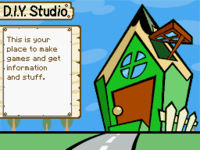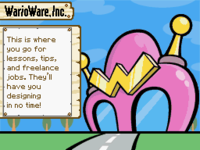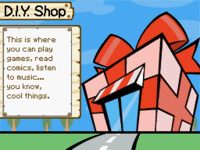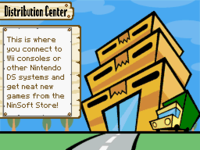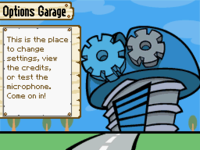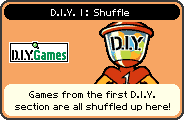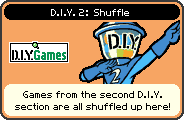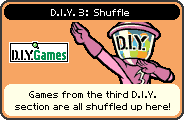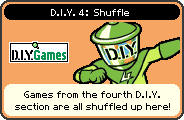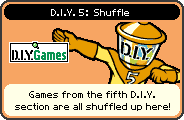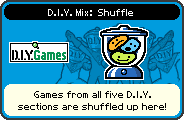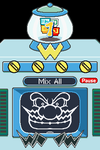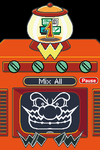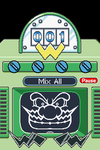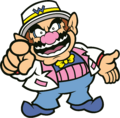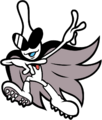WarioWare: D.I.Y.: Difference between revisions
m (→Development) |
Bro Hammer (talk | contribs) |
||
| Line 153: | Line 153: | ||
|align="left"|Just like [[18-Volt]]'s stage in ''[[WarioWare: D.I.Y. Showcase]]'', 9-Volt's stage is based on a classic game. 9-Volt stars in the game ''Super 9-Volt'', based on the game ''[[Super Mario Bros.]]''. | |align="left"|Just like [[18-Volt]]'s stage in ''[[WarioWare: D.I.Y. Showcase]]'', 9-Volt's stage is based on a classic game. 9-Volt stars in the game ''Super 9-Volt'', based on the game ''[[Super Mario Bros.]]''. | ||
|- | |- | ||
|'''All''' | |[[File:WWDIY Shuffle SI.png|40px]]<br>'''All''' | ||
|[[File:Shuffle | |[[File:Diamond Shuffle DIY.png]] | ||
|align="left"|No story. Wario's TV turns on, and the player must be ready to play some microgames. After four microgames are played, the speed will get higher or a boss game will be played. This stage is unlocked after encountering all Diamond Software microgames at least once. | |align="left"|No story. Wario's TV turns on, and the player must be ready to play some microgames. After four microgames are played, the speed will get higher or a boss game will be played. This stage is unlocked after encountering all Diamond Software microgames at least once. | ||
|- | |- | ||
|'''All''' | |[[File:WWDIY Ultra Hard SI.png|40px]]<br>'''All''' | ||
|[[File:Ultra Hard Portrait DIY.png]] | |[[File:Ultra Hard Portrait DIY.png]] | ||
|align="left"|No story. Wario's TV turns on, and the player must be ready to play some microgames. Microgames are at high speed from the beginning of the stage. This stage is unlocked after clearing 30 points in the Diamond Software: Shuffle stage. | |align="left"|No story. Wario's TV turns on, and the player must be ready to play some microgames. Microgames are at high speed from the beginning of the stage. This stage is unlocked after clearing 30 points in the Diamond Software: Shuffle stage. | ||
| Line 166: | Line 166: | ||
These stages utilize microgames the player has saved to their shelves in the [[D.I.Y. Shop]]. Clearing 15 points in the Diamond Software: Ultra Hard stage unlocks the option to assign any Diamond Software theme (aside from Jimmy T.'s) to these stages, giving them the story and boss stage of their respective host. | These stages utilize microgames the player has saved to their shelves in the [[D.I.Y. Shop]]. Clearing 15 points in the Diamond Software: Ultra Hard stage unlocks the option to assign any Diamond Software theme (aside from Jimmy T.'s) to these stages, giving them the story and boss stage of their respective host. | ||
{|width=100% border="1"cellspacing=0 cellpadding=3 style="border-collapse:collapse; text-align: center;" | {|width=100% border="1"cellspacing=0 cellpadding=3 style="border-collapse:collapse; text-align: center;" | ||
!Theme | |||
!Stage | !Stage | ||
! | !Content | ||
!Play | !Play | ||
|- | |- | ||
|'''D.I.Y. 1''' | |'''D.I.Y. 1''' | ||
|[[File:Shuffle Portrait DIY.png]] | |||
|All microgames on Shelf 1 | |All microgames on Shelf 1 | ||
|Play the microgames. After five microgames are played, the speed will get higher. | |Play the microgames. After five microgames are played, the speed will get higher. | ||
|- | |- | ||
|'''D.I.Y. 2''' | |'''D.I.Y. 2''' | ||
|[[File:DIY2 Portrait DIY.png]] | |||
|All microgames on Shelf 2 | |All microgames on Shelf 2 | ||
|Play the microgames. After five microgames are played, the speed will get higher. | |Play the microgames. After five microgames are played, the speed will get higher. | ||
|- | |- | ||
|'''D.I.Y. 3''' | |'''D.I.Y. 3''' | ||
|[[File:DIY3 Portrait DIY.png]] | |||
|All microgames on Shelf 3 | |All microgames on Shelf 3 | ||
|Play the microgames. After five microgames are played, the speed will get higher. | |Play the microgames. After five microgames are played, the speed will get higher. | ||
|- | |- | ||
|'''D.I.Y. 4''' | |'''D.I.Y. 4''' | ||
|[[File:DIY4 Portrait DIY.png]] | |||
|All microgames on Shelf 4 | |All microgames on Shelf 4 | ||
|Play the microgames. After five microgames are played, the speed will get higher. | |Play the microgames. After five microgames are played, the speed will get higher. | ||
|- | |- | ||
|'''D.I.Y. 5''' | |'''D.I.Y. 5''' | ||
|[[File:DIY5 Portrait DIY.png]] | |||
|All microgames on Shelf 5 | |All microgames on Shelf 5 | ||
|Play the microgames. After five microgames are played, the speed will get higher. | |Play the microgames. After five microgames are played, the speed will get higher. | ||
|- | |- | ||
|''' | |[[File:WWDIY Shuffle SI.png|40px]]<br>'''All''' | ||
|[[File:DIY Mix Shuffle Portrait DIY.png]] | |||
|All D.I.Y. Games | |All D.I.Y. Games | ||
|Play the microgames. After five microgames are played, the speed will get higher. | |Play the microgames. After five microgames are played, the speed will get higher. | ||
|- | |- | ||
|''' | |[[File:WWDIY Ultra Hard SI.png|40px]]<br>'''All''' | ||
|[[File:Ultra Hard Portrait DIY.png]] | |||
|All D.I.Y. Games | |All D.I.Y. Games | ||
|Play the microgames. Microgames are at high speed from the beginning of the stage. | |Play the microgames. Microgames are at high speed from the beginning of the stage. | ||
Revision as of 22:07, November 9, 2023
| WarioWare: D.I.Y. | |||||||||||
|---|---|---|---|---|---|---|---|---|---|---|---|
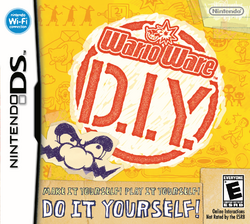 American box art For alternate box art, see the game's gallery. | |||||||||||
| Developer | Nintendo SPD Group No.1 Intelligent Systems | ||||||||||
| Publisher | Nintendo | ||||||||||
| Platform(s) | Nintendo DS | ||||||||||
| Release date | Template:Release[?] | ||||||||||
| Language(s) | English (United Kingdom) English (United States) French (France) German Spanish (Spain) Italian Japanese | ||||||||||
| Genre | Action, Creativity | ||||||||||
| Rating(s) |
| ||||||||||
| Mode(s) | Single player | ||||||||||
| Input | Nintendo DS:
| ||||||||||
WarioWare: D.I.Y. is the sixth game in the WarioWare series. The game is officially called WarioWare: Do It Yourself in European languages, but the "D.I.Y." abbreviation is still included everywhere in the game and also present on the game's logo.
The game was confirmed on October 2 at the Fall 2008 Nintendo Conference, where a very short video clip was shown. The American release was first announced at E3 2009.[1] The European release date was first announced at Nintendo's European conference on January 25, 2010. The game was released in Japan and the ROC on April 29, 2009, in North America on March 28, 2010, in Europe on April 30, 2010, and in Australia on May 20, 2010.
The second WarioWare game for the Nintendo DS allows the player to create their own microgames, records, and comics, hence the title (D.I.Y. is short for "Do It Yourself"). The content could be shared via the Nintendo Wi-Fi Connection.[2] However, the service was terminated on May 20, 2014, making this game's content no longer shareable online.
Storyline
At his home, Dr. Crygor is dreaming that he is playing a video game, up to a point where the characters of the game come out of the TV screen and fly toward him. Crygor wakes up and, inspired by his nightmare, creates a game-creation device named the Super MakerMatic 21. The next morning, Wario comes in with a broken TV and demands that Dr. Crygor fixes it, before noticing the Super MakerMatic 21 production line. He mistakes them for TV sets and asks to do a trade, but after Dr. Crygor explains to him its function, Wario is convinced it is his next opportunity to become rich.
Sometime before the events of the game, several WarioWare, Inc. employees left the company to work for competitor Diamond Software, causing Wario to hire the player as a game creator.
Features
Editor
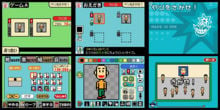
WarioWare D.I.Y is focused on user-generated content. The player can make graphics, records, and logic routines for their microgames. The tools for creating the artwork are partly taken from Mario Paint, and even the respective graphics resemble the visuals of the named game. Furthermore, D.I.Y. offers the possibility to create comics or records.
Before being able to use the editing tools, the player has to go through a six-step tutorial (named "D.I.Y 101") explaining the basics of the interface and the editor's programming syntax. Further lessons are available.
The tools for graphical editing include different pencil tools, a spray can, a fill tool, and an eraser. They are used for both background elements, and sprites, which can be easily placed and moved around. The game allows the programming of logic routines to define the game's rules. The editor is restricted to tapping motions for input, as the development team wanted to keep content creation simple.[3]
Music can be made as well. The respective tool is similar to the Music Mode of Mario Paint. Instead of manually placing the notes on the music score, the player can also sing through the DS's microphone, which the DS then converts into the notes. Many of the instruments usable for the created melody originate from Mario Paint. The premade sound effects are partly taken from Mario Paint as well.
Players can send their creations to other D.I.Y. owners or receive other people's works. Before the discontinuation of the Nintendo Wi-Fi Connection, they could also be uploaded to Nintendo for contest purposes. Microgames made available by Nintendo were also available for download. Additionally, the WiiWare game WarioWare: D.I.Y. Showcase allows the player to play the microgames on the Wii.
Pre-built content
Ninety premade microgames are available from the beginning. They are split into five different sets hosted by different WarioWare characters. The microgames are made with the in-game creation tool and thus are more simplistic than those in previous installments, featuring one difficulty level instead of three and a varying number of alternate scenarios. Microgame sets are unlocked based on the DS's internal clock, with one character being unlocked per day. As the editor is restricted to tapping motions, the microgames are grouped by visual theme, similar to WarioWare, Inc.: Mega Microgame$!
In addition to microgames, the game also features several pre-built comics and music records. Comics, much like microgames, are unlocked based on the system's internal clock while records are unlocked by obtaining any of the 120 medals linked to in-game milestones. However, because Nintendo Wi-Fi Connection is now unavailable, it is no longer possible to obtain medals 104 to 114 due to them being related to online interactions.
Content ID
Every piece of content in WarioWare: D.I.Y. contains an ID consisting of a single letter describing the type of material, four letters identifying the creator, a four-digit number that is unique to that material, and a three-digit number.
The first letter of the ID identifies the type of material as follows:
- G: Microgames
- M: Comics
- R: Records
While the next four letters vary depending on creator, these are the following based on built-in content:
Comic creators also have their own ID codes:
- SIRI: Kotobuki Shiriagari
- ISAM: Isami Nakagawa
- SEKA: Sekaiichi Asakura
- AMAH: Masakazu Amahisa
- BETU: Rei Betsuyaku
If the player imports games from WarioWare: D.I.Y. Showcase, their creators have their own unique codes as well:
- WARI: Wario-Man
- DRIB: Dribble & Spitz
- KATA: Kat & Ana
- EIGH: 18-Volt
Modes
The game is divided into 5 sections:
D.I.Y. Studio
In the D.I.Y Studio, the player can create microgames and look at their achievements.
- Super MakerMatic 21. With the Super MakerMatic 21, the player can create microgames, records, or comics.
- D.I.Y. Data. This shows the total number of sales, connections, contests entered, and medals. The more medals earned, the more records unlocked.
- D.I.Y. Forum. The D.I.Y. forum is also located here, which can sometimes give out helpful hints.
WarioWare, Inc.
Here, the player can finish premade games. The player can also learn basic or advanced MakerMatic tricks.
- D.I.Y. 101 (known as D.I.Y ABCs in the British English version). Here the player can follow the game's tutorials hosted by Penny and Wario.
- Assembly Dojo. The Assembly Dojo appears when all the tutorials are passed. In the Dojo, the player can master thirty-two different techniques. It is hosted by Young Cricket & Master Mantis.
- Job Center. The Job Center (parsed Job Centre in the British English version) is where a player can draw art for unfinished microgames. The player can also change the name of the microgame. They can also import the game and change stuff besides the name and the custom art. There are sixteen job microgames the player can draw art for and rename. The player can save and play the game as well, before shipping it.
D.I.Y. Shop
All of the pre-installed and D.I.Y. products are stored here.
- Games. Play saved microgames made by the player or Diamond Software. The player can "blend" games together in the Game Blender.
- Record. Listen to saved records made by the player or Diamond Studios. The player can mix the music in the Jukebox.
- Comics. Read saved comics made by the player or Diamond Publishing.
- Sales Charts. The sales chart shows the most sold games. The list gets updated daily.
Distribution Center
Players can share their D.I.Y. creations with others along with the registration of friend codes. The player can also connect to the NinSoft Store.
- Wii. Send or receive products from WarioWare: D.I.Y. Showcase.
- DS. Send or receive products from another copy of WarioWare: D.I.Y.
- WFC (WFC is short for Wi-Fi Connection). Save D.I.Y. products on the Internet so registered friends can download them. The NinSoft Store could also be accessed for Weekly Games, Big Name Games, and Contests. However, because Nintendo Wi-Fi Connection was discontinued in May 2014, WFC games are no longer accessible.
Options Garage
Change the game's settings such as company name or watch the credits.
- Change Name. Change the player's name.
- Change Brand name. Change the name of the player's company.
- Sound Settings. Change the sound setting from DS speakers to headphone speakers.
- Microphone Test. Test how well the player's voice is recorded by the microphone.
- Staff Credits. Watch the credits.
- Clear Data. Delete all saved WarioWare: D.I.Y. data.
Game Blender
- Main article: List of WarioWare: D.I.Y. microgames
The Game Blender serves as the game's menu for playing stages of microgames with either pre-built microgames, the player's microgames or a mixture of both. It is found in the Games room of the D.I.Y. Shop.
Diamond Software
- Main article: Diamond Software
![]() Games under this category are made by former members of Wario's crew, working under the brand name of Diamond Software. Each character's stage consists of 18 microgames with a common theme, and a story presented like a television program. Unlike previous WarioWare titles, stages do not end after clearing the boss microgame on the first playthrough, and the player must wait 24 hours after clearing a stage's target to unlock the next one. Encountering a Diamond Software microgame in the Game Blender adds it to the D.I.Y. Shop, which allows the player to play it individually, as well as view, import, and edit it with the Super MakerMatic 21. The microgame sets are listed as follows:
Games under this category are made by former members of Wario's crew, working under the brand name of Diamond Software. Each character's stage consists of 18 microgames with a common theme, and a story presented like a television program. Unlike previous WarioWare titles, stages do not end after clearing the boss microgame on the first playthrough, and the player must wait 24 hours after clearing a stage's target to unlock the next one. Encountering a Diamond Software microgame in the Game Blender adds it to the D.I.Y. Shop, which allows the player to play it individually, as well as view, import, and edit it with the Super MakerMatic 21. The microgame sets are listed as follows:
| Theme | Stage | Story |
|---|---|---|
Strange |
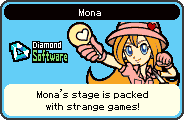
|
Working as a reporter for her television show, Mona: Temple Explorer!, Mona and Joe find an ancient temple in a jungle, and enter it to find hidden treasure. They exit the temple when the stage ends. |
Sports |
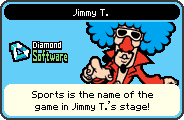
|
Jimmy appears in a new aerobics program on TV, titled Jimmy's Aerobics, and performs exercises along with two other participants. |
Food |
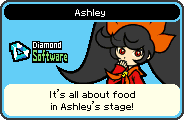
|
Ashley & Red are in a forest outside their mansion, filming a movie titled Magical Witch Ashley. When the player loses all four chances for this set, the cameramen and director appear, which all seem to be ghosts. |
IQ |

|
The launch of a rocket ship is being covered by Diamond News. While counting for liftoff, Orbulon flies his Oinker over the launch pad, and is struck by lightning. Orbulon falls out and gets stuck in the rocket ship, just before takeoff. It then launches with Orbulon, sending him to space. After the rocket discharges all of its sections, Orbulon falls back to earth. While not shown in-game, Orbulon's story is entitled Orbulon's Blastoff on the European website. |
Nintendo |
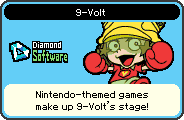
|
Just like 18-Volt's stage in WarioWare: D.I.Y. Showcase, 9-Volt's stage is based on a classic game. 9-Volt stars in the game Super 9-Volt, based on the game Super Mario Bros.. |
All |

|
No story. Wario's TV turns on, and the player must be ready to play some microgames. After four microgames are played, the speed will get higher or a boss game will be played. This stage is unlocked after encountering all Diamond Software microgames at least once. |
All |
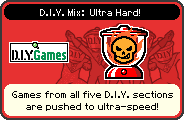
|
No story. Wario's TV turns on, and the player must be ready to play some microgames. Microgames are at high speed from the beginning of the stage. This stage is unlocked after clearing 30 points in the Diamond Software: Shuffle stage. |
D.I.Y. Games
![]() These stages utilize microgames the player has saved to their shelves in the D.I.Y. Shop. Clearing 15 points in the Diamond Software: Ultra Hard stage unlocks the option to assign any Diamond Software theme (aside from Jimmy T.'s) to these stages, giving them the story and boss stage of their respective host.
These stages utilize microgames the player has saved to their shelves in the D.I.Y. Shop. Clearing 15 points in the Diamond Software: Ultra Hard stage unlocks the option to assign any Diamond Software theme (aside from Jimmy T.'s) to these stages, giving them the story and boss stage of their respective host.
Mix All
The Mix All option allows players to play a microgame stage with all of the microgames present in their shelves and Diamond Software's shelves combined and is unlocked by clearing 15 points in the Diamond Software: Ultra Hard stage.
Downloadable microgames
- Main article: List of WarioWare: D.I.Y. downloadable microgames
The Wario Award Contest
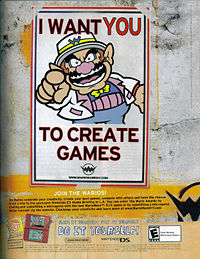
This poster announced the first official contest for WarioWare: D.I.Y. in the U.S. and Canada. The poster is a homage to a popular World War I propaganda poster created by J.M. Flagg.
A special contest known as The Wario Award Contest (also called The Wario Awards, Join the Warios or just The Warios) was held in conjunction with the North American version's release and was related to the first American design challenges. It ran from March 28 to May 16, 2010 and was open to residents of the United States and Canada (except Quebec). The contest was first announced through a print ad. Participants had the chance to win a trip to the Nintendo E3 Media Briefing in Los Angeles.
Players had to design a microgame using a theme of creatures, sports, or machines. When finished, the game had to be submitted within WarioWare: D.I.Y. for the respective design challenge. Afterwards, the player had to fill out the fields of the form at the official website as previously entered on the game screen to finish the entry. It was also possible to submit a microgame design concept via the game's website without owning the game by filling out the other form.
Contests
- Main article: List of WarioWare: D.I.Y. contests
Staff
- Main article: List of WarioWare: D.I.Y. staff
Goro Abe and Taku Sugioka served as chief director and director of the game respectively. This was the last entry in the Super Mario franchise to credit Hiroji Kiyotake as Wario's original designer.
Development
Director Goro Abe thought the microgame format was well-suited to content creation due to their simplicity and short development time, and thus believed players could have fun creating microgames. Following the completion of WarioWare, Inc.: Mega Party Game$!, Abe wrote a text file describing a software creation game using the WarioWare system for the Iris (the codename for the successor to the Game Boy Advance, which would eventually evolve into the Nintendo DS). However, Abe felt the pitch "missed something" and due to the difficulties of making the editor accessible, it was put on hold as he focused on other projects.[4]
When the Wii was developed, various Nintendo departments held meetings to discuss the new console. Abe was the representative of Nintendo Software Planning & Development and learned that the Wii and DS could exchange data via Nintendo Wi-Fi Connection. This information inspired him to build on his previous pitch.[4]
Following the completion of WarioWare: Smooth Moves, Goro Abe shared his idea with fellow SPD 1 employee Takumi Hatakeyama. Hatakeyama was interested in the pitch as he had fond memories of creating content on Mario Paint, despite sharing Abe's inability to focus on completing longer, more involved content.[4] Goro Abe also invited Intelligent Systems employee Taku Sugioka, who too was interested in the idea, but he was unsure of the feasibility of the project.[4]
The team decided to base the music and drawing tools on Mario Paint. As there was no template for the game content-creation aspect, the developers felt it was the aspect that was the hardest to implement – according to Abe, half of the game's 2-years development cycle was spent on experimenting to create an approachable editor.[4] It was eventually decided that microgame creation would be split into three components: "objects" (moving sprites), "background" (static graphics) and "sound". To integrate the sound and graphic creation tool in the game editor, the development team created a test model which surprised them with its efficiency when a designer with little programming experience was able to make a game within a few hours.[4]
The first version of the editor was far less complex than that of the final version, the approach being to start with a small number of necessary functions and add others if necessary, rather than having an overly complex editor and removing unnecessary functions.[4] To test its capabilities, the development team set to recreate Wario's stage in WarioWare: Touched! They were able to replicate "almost 100%", with some adjustments made to games that could not be fully recreated.[4] During developments, Abe emphasized to the other staff members that it was unnecessary to create highly complex and technical games, as they would only last a few seconds.
Taku Sugioka lobbied for the game to be shipped on a NAND cartridge due to the format's faster rewrite speed and increased storage capacity, which caused the game to be slightly delayed due to issues debugging the new format.[4]
As the development team knew not all consumers would be interested in creating games at first, the ability to edit pre-made microgames was added. The game's 90 microgames were specifically designed to provide a wide variety of templates and assets.[4]
Reception
| Reviews | |||
|---|---|---|---|
| Release | Reviewer, Publication | Score | Verdict |
| Nintendo DS | Carig Harris, IGN | 9/10 | "This is truly Mario Paint for the Nintendo DS generation. Don't get WarioWare D.I.Y. if you're just interested in playing through the next batch of microgames from Nintendo; get it to show off that you have what it takes to do what Nintendo does. I love WarioWare D.I.Y. as a creative outlet: game builders have been around since the '80s but this is the first time I found myself truly engrossed in the process of building a game from scratch because of how simple yet powerful it is. Sure, when all is said and done there's not much to a five to 10-second "tap the screen" mini-game, but the fact that you can get something up and running and working in a short amount of time definitely fuels that sense of satisfaction and instant gratification." |
| Nintendo DS | Corbie Dillard, Nintendo Life | 9/10 | "Being able to create your own microgames is a dream come true for many fans of the WarioWare series and the developers have come through with flying colors in delivering not only a very functional set of creation tools, but a package that is easy enough for just about anyone to make good use of. While the built-in games aren't quite of the variety and calibre of some of those found in previous WarioWare releases, they're still quite enjoyable and a nice blueprint for those setting out to create their own games. Fans looking to purchase WarioWare D.I.Y. simply to play the microgames might be a bit disappointed with the lack of variety in the included titles, but those who are willing to put in the time and effort to become familiar with the creation tools will likely find a very powerful and rewarding gaming experience limited only by their imaginations and free time." |
| Nintendo DS | Christian Donlan, Eurogamer | 8/10 | "Perhaps hoping for proper online is missing the point, however. With its bright colours and bizarre comics, WarioWare DIY is built for the playground: built to allow you to hack a game together on a lunch break and show it to your friends during double maths. The uncomfortable truth, perhaps, is that Nintendo's take on user-generated content works because of what's left out, rather than what made it in. That's why the end result is constrained, but necessarily so: another effortless piece of cleverness, another modest marvel." |
| Aggregators | |||
| Compiler | Template:Nowrap | ||
| Metacritic | 82 | ||
| GameRankings | 84.64% | ||
Gallery
- For this subject's image gallery, see Gallery:WarioWare: D.I.Y.
Media
| File info |
References to other games
- Mario Paint: When the player is creating a microgame (or comic) and gives it the name "Mario Paint", the original Mario Paint music plays in the graphic editor instead of the normal music. The same goes for importing 9-Volt's microgame, Mario Paint, or viewing it in the Game MakerMatic.
- WarioWare: Smooth Moves: All characters' voice clips were reused from this game.
- Rhythm Heaven: The Do-Re-Mi voice icon is modeled after a character in the Love Lab from Rhythm Heaven, another series created by Nintendo SPD Group No.1.
References in later games
- WarioWare: Get It Together!: Mona's pith helmet appears in her room during the her story's intro.
Names in other languages
| Language | Name | Meaning | Notes |
|---|---|---|---|
| Japanese | メイド イン 俺[?] Meido in Ore |
Made in Me The word "ore" (俺) is an informal Japanese first-person pronoun and is usually avoided in work titles unless, among other motives, the air of informality is sought. In this case, it represents Wario, as well as the overall theme of WarioWare. |
|
| Chinese (traditional) | 本大爺工作室[5] Běn Dàyé Gōngzuòshì |
My Studio |
Trivia
- If the player closes the system on the music creation tool then opens it up again, the black notes will be seen playing around before going back to their positions.
References
- ^ Press.Nintendo.com: Nintendo Unveils Its Video Game Lineup For Early 2010 (12/14/2009)
- ^ 1UP.com: Make Your Own WarioWare Games (04/08/2009)
- ^ Nintendo Everything: Sakamoto discusses Metroid: Other M and WarioWare: D.I.Y.
- ^ a b c d e f g h i j Iwata Asks: WarioWare D.I.Y
- ^ Official Nintendo Taiwan website
External links
- North American manual
- Official Japanese Website
- Official North American Website (Web Archive)
- Official North American Gamepage
- Official European Website
- Official Australian Webpage
| WarioWare: D.I.Y. | |
|---|---|
| Main characters | Wario • Dr. Crygor • Penny • Mona • Jimmy T. • Ashley • Red • Orbulon • 9-Volt |
| Minor characters | Abby • Young Cricket • Master Mantis |
| Microgames | Mona • Jimmy T. • Ashley • Orbulon • 9-Volt • Job Center • D.I.Y. 101 |
| Locations | D.I.Y. Shop • D.I.Y. Studio • WarioWare, Inc. • Assembly Dojo • Distribution Center • Options Garage |
| Other | Super MakerMatic 21 • D.I.Y. Forum • Record (list) • Comics • Medals • Bomb |
| Further information | Gallery • Staff • Contests |

